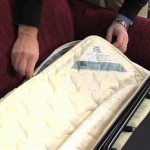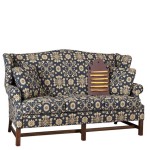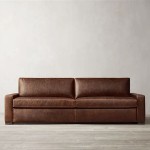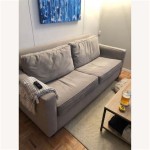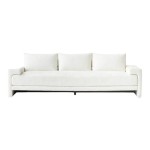How To Assemble A Sectional Sofa
Assembling a sectional sofa can appear daunting, but with a systematic approach and the right tools, the process becomes manageable. This article provides a comprehensive guide for assembling a typical sectional sofa. Always refer to the manufacturer's specific instructions, as variations may exist between models.
Preparation is Key: Before beginning assembly, it is crucial to prepare the designated area. Choose a spacious, well-lit location that allows ample room to maneuver the sections. Lay down a protective covering, such as cardboard or a drop cloth, to prevent damage to the sofa or flooring during assembly. Gather necessary tools, typically including a screwdriver, Allen wrench (often provided), and possibly a mallet or rubber hammer. Unpack all boxes carefully, identifying and organizing all components according to the manufacturer’s instructions. This includes cushions, hardware, legs, and individual sofa sections. Confirm that all parts listed in the inventory are present before proceeding.
Connecting the Individual Sections: Most sectional sofas utilize a simple locking or latching mechanism to connect the individual sections. These mechanisms can vary in design, from brackets and clamps to slide-in connectors. Carefully align the designated connection points on the adjoining sections. Ensure correct orientation, typically indicated by markings or labels on the fabric or frame. Once aligned, engage the locking mechanism, either by sliding, pushing, or clamping the pieces together. Some mechanisms might require the use of the provided Allen wrench or screwdriver to secure the connection. Listen for an audible click or feel a secure fit to confirm successful attachment.
Securing the Connections: After connecting the sections, it is essential to reinforce these connections for stability and longevity. This typically involves tightening bolts or screws located within the connecting mechanisms. Use the appropriate Allen wrench or screwdriver to tighten these fasteners, ensuring they are snug but not over-tightened, which could damage the frame. The manufacturer's instructions will specify the recommended torque or tightness.
Attaching the Legs (if applicable): Many sectional sofas require leg attachment. Locate the pre-drilled holes on the underside of the sofa sections. Carefully align the legs with these holes and insert the provided hardware, typically bolts or screws. Tighten the hardware using the appropriate tool, ensuring a secure fit. Avoid over-tightening, which could strip the threading or damage the frame. Check the levelness of the sofa after attaching all legs. Slight adjustments may be needed by tightening or loosening individual leg attachments.
Adding the Cushions and Backrests: Once the sectional framework is assembled and the legs are attached, it’s time to add the cushions and backrests. Place the cushions in their designated positions as outlined in the manufacturer's instructions. Backrests might involve a simple placement or a locking mechanism similar to that used for connecting the sections. Ensure all cushions and backrests are securely in place.
Inspecting the Assembled Sofa: After completing the assembly process, carefully inspect the entire sofa for any loose connections, missing hardware, or damage. Ensure all sections are securely attached and that the sofa is level and stable. Test the functionality of any reclining mechanisms or pull-out beds if applicable, following the manufacturer’s instructions. Address any issues immediately before regular use.
Troubleshooting Common Issues: While assembly is typically straightforward, occasional challenges may arise. If sections do not align correctly, double-check the orientation and alignment markings. If hardware does not fit, ensure the correct size and type are being used, as specified in the instructions. For persistent difficulties, consult the manufacturer’s troubleshooting guide or contact customer support for assistance.
Maintenance and Care: Proper maintenance can extend the lifespan of the sectional sofa. Regular cleaning, following the manufacturer’s recommendations for fabric care, will help maintain its appearance. Periodically check and tighten any loose hardware. Avoid placing the sofa in direct sunlight or near heat sources, which can damage the fabric or frame. Rotating the cushions periodically ensures even wear.
Disassembly and Moving: Should you need to move or relocate the sofa, understanding the disassembly process is important. Refer to the assembly instructions, typically provided in reverse order for disassembly. Carefully disconnect the sections, ensuring no damage occurs to the connecting mechanisms. Remove the legs and store all hardware and components securely for future reassembly.
Following these steps will facilitate a smooth and efficient assembly process. Remember, meticulous attention to detail and adherence to the manufacturer's instructions are paramount for a successfully assembled and long-lasting sectional sofa.

How To Assemble A Sectional Sofa With Ottoman

How To Assemble A Sectional Sofa With Ottoman

Unboxing And Assembling A Two Piece Sectional Sofa

Sectional Sofa With Ottoman Assembly

How To Assemble A Sectional Sofa With Ottoman

Assembling Our Sectional Sofa We Love It Young House

How To Install Shintenchi Convertible Sectional Sofa

Assembling Our Sectional Sofa We Love It Young House

How To Assemble Sectional Sofa

Sobaniilo Convertible Sectional Sofa Couch Modern Linen Fabric L Shaped 3 Seat With Reversible Chaise For Small Space Light Gray Com

